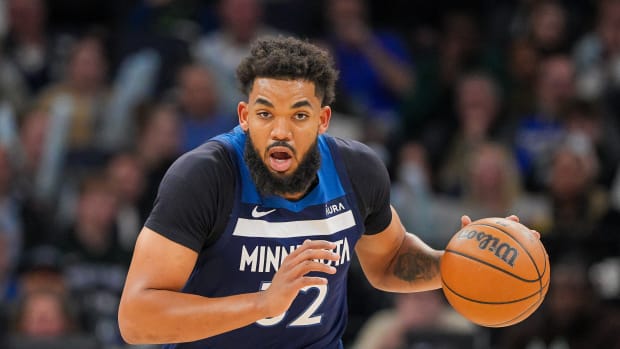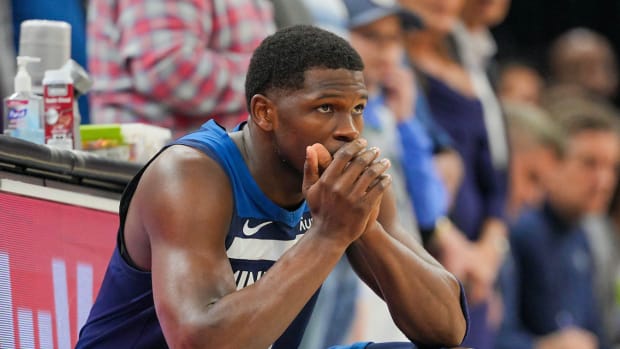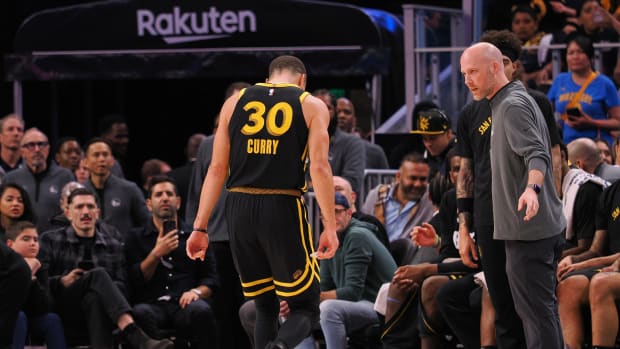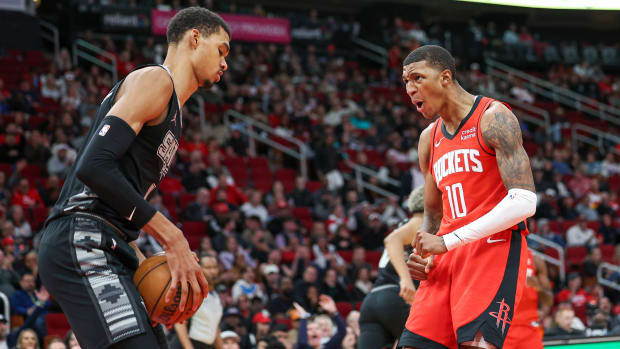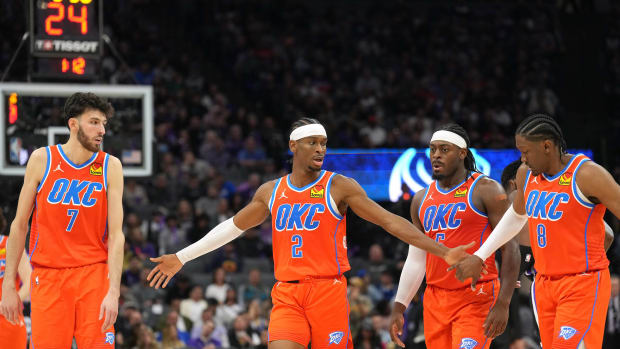Isaiah Thomas: The Boston Celtics' Little Ticket
This story is in the February 17, 2017, issue of SPORTS ILLUSTRATED. To subscribe, click here.
Three hours before a late-January game in Washington, Isaiah Thomas, the Celtics’ 5'9" All-Star point guard, walks slowly through a Verizon Center tunnel, like a beleaguered civil servant going to work on a cold Tuesday morning, and onto the lacquered floor of the playing surface. The seats are empty, there is no music playing, and building personnel are bustling about. The hockey ice below the court keeps the air chilled. Thomas wears a green, long-sleeved shirt over practice shorts, three-quarter-length compression tights and low black Nikes with a green swoosh. No headband, not until the curtain goes up. “That’s for fashion,” he says. (And also an homage to Jason Terry, the 18-year NBA veteran and friend from their shared Seattle-Tacoma home area; Terry’s headband is an homage to ’70s-vintage Seattle Supersonics guard Slick Watts.) Assistant coach Jerome Allen begins feeding Thomas passes, and Thomas begins shooting, as he does three hours before every game, because Terry told Thomas early in his career to find a routine and stick with it. This is part of Thomas’s routine.
Thomas shoots for 20 minutes, flicking soft, lefthanded jumpers, first from 15 feet out. He shoots with his body angled at 45 degrees to the backboard, left foot forward, the ball held low in front of his forehead and then snapped at the rim. It is a sudden movement, distinctly different from, say, Klay Thompson’s silky motion. Thomas extends his arc until he is well past the top of the circle, receives a pass from Allen and then turns to find his vision suddenly blocked by a member of the Wizards’ dance team, which has quietly taken the floor for rehearsal. Thomas at first squares up and then pauses, stymied. It is an instructive moment: The dancer is taller than the second-leading scorer in the NBA. Taller than a man who in late December scored 29 of his career-high 52 points in the fourth quarter of a win over the Heat (the second-highest-scoring fourth quarter in NBA history, behind Wilt Chamberlain’s 31 the night he finished with 100 in 1962). Taller than the catalyst of the Celtics’ rebirth, which at week’s end had taken them within 2 1⁄2 games of the No. 1 seed in the Eastern Conference. (To be fair, the dancer is wearing fancy white boots that might be giving her a lift. Still. ...) After a moment’s awkwardness, she steps aside and Thomas drains a 25‑footer while laughing. Then the shooting continues.
Thomas has always been short. He was not one of those kids who matured young and became dominant in sports, only to stall out and watch other boys catch up and pass him. In the third-grade class picture from Naches Trail Elementary School in Tacoma, Wash., he is smack in the middle of the second row, wearing a billowing, yellow Lakers’ baseball jersey that falls nearly to the floor, flanked by two girls taller than he is. Thomas’s father is 5'6". His grandfather was 5'6". Upon reaching adolescence and still awaiting a growth spurt, Thomas tried to accelerate the process. “In my basement, he had one machine that was supposed to stretch him out and another machine so he could hang upside down,” says Thomas’s mother, Tina Baldtrip (5'7"). Thomas would tell everyone that he was going to be 6 feet someday, but he is 27 years old and that day is not coming.
He has adapted just fine. In a year full of stunning individual performances, Thomas has made his case as the NBA’s most compelling player. Thomas, who is in his second full season with Boston, has raised his scoring average from 22.2 a year ago to 29.9 (second to Russell Westbrook’s 30.8), including a streak of 34 games scoring at least 20 points. His average of 10.7 points in the fourth quarter leads the league by a wide margin, the highest since the NBA began tracking the statistic in 1996 and the foundation of his growing legend. After hitting jumpers on three straight possessions to close out a Jan. 13 victory in Atlanta, Thomas pointed at his left wrist and shouted “My time! My time!” He scored 24 points in the fourth quarter (and 41 overall) in a 113–109 win over the Pistons in Boston on Jan. 30. After that game Detroit coach Stan Van Gundy said, “When they hit the fourth quarter . . . he’s just a one-man team.” Thomas has scored 20 or more points in the fourth quarter four times this season; no other player has done it more than once. “That’s just me,” says Thomas. “That’s me in those moments. Like I say, the fourth quarter isn’t for everybody.”
He has lifted the Celtics on his back. In the fourth season since Brad Stevens was hired away from Butler by general manager Danny Ainge to oversee the rebuilding of one of the league’s foundation franchises, Boston is 32–18, on pace to win more than 50 games for the first time since 2011, the penultimate season of the Big Three and Rondo. The C’s have been helped by the off-season acquisition of center Al Horford, the drafting of rookie swingman Jaylen Brown and the continued development of forward Jae Crowder and guards Marcus Smart and Avery Bradley. But the team’s blood flows through Thomas’s veins. “He makes the decisions, when to attack, when to dish it,” says Horford. “And he brings it every night.”
Most remarkably, Thomas does these things while rising 69 inches from floor to headband. According to StatsPass, in the last 40 years there have been just 55 NBA players under 6 feet tall (and only 12 were 5' 9" or shorter). This list doesn’t include some of the best little men in history: Allen Iverson officially played at 6 feet; Nate Archibald was listed at 6'1", ditto John Stockton. Thomas has his own personal list: “Nate Robinson, Tiny Archibald, Allen Iverson, Calvin Murphy, Muggsy Bogues, Spud Webb, Terrell Brandon,” he says, and then mentions another, 5'10" lefthander Damon Stoudamire, who played 13 years, including eight in Portland when Thomas was growing up in the Northwest. “He had a Mighty Mouse tattoo,” says Thomas. “So one of my first tattoos was Mighty Mouse.” It’s inked into Thomas’s right arm.
The highest single-season scoring average by a player under 6 feet is 5'10" Michael Adams’s 26.5 in 1990–91; Adams shot just 39.4% (and 29.6% from beyond the arc) for the freewheeling Nuggets, while Thomas is a 47.0% shooter. Murphy is the only other sub-6-footer to have averaged more than 25 points: 25.6 in 1977–78, without the three-point line. Thomas stands to obliterate those numbers.
Thomas succeeds while playing with an intense fury, much the same as he played as a kid. “Exact same game,” says Terry. “Fearless, pit-bull competitor, not backing down from anybody.” He is an outstanding three-point shooter (a career-best 38.8% this year, rising to 42.5% in the fourth quarter), but his game grows from relentless attacks on the rim. “He gets low and he explodes,” says Jamal Crawford of the Clippers, a 15-year NBA veteran and, like Terry, a friend and mentor to Thomas from back home. “He’s like an NFL running back going through holes.” Thomas is built accordingly, a solid 180 pounds.
“It’s truly amazing what he’s able to accomplish in that regard, getting to the rim at his height,” says Stevens. “Here’s a guy that’s always had to figure out how to do it. And boy, has he figured it out. He’s got that ultimate chip on his shoulder where there is no success that can make him take his foot off the pedal and no slight that he misses.”
Now Thomas is sitting on a tall chair in a hallway near the visitors’ locker room in Washington. It has been a dizzying season so far, and four months lie ahead. In his sixth NBA season (with his third team), Thomas has both given his own jersey to Floyd Mayweather at courtside in Boston and worn a jersey from Tom Brady on the Patriots’ sideline in Foxborough. He both denies and embraces his size. “Honestly,” he says, “I don’t see height. I just, I figure out a way. I’ve been doing it my whole life. I’ve been the smallest player on every court I’ve ever been on in my life. But I don’t feel small. I feel as big as everybody else.”
Since early childhood, Thomas has mixed his lack of height with a thunderous, unshakable drive. When he was between 10 and 14 years old, Isaiah would travel with his father, Keith, all over Tacoma for weekend pickup games—with adults. They would play at the People’s Community Center, at the Pearl Street YMCA and sometimes at McCord Air Force Base. “Isaiah was a little kid and most of the guys were grown men,” says Keith. “And Isaiah was cocky, and he had a smart mouth on him. He’d beat those guys and talk about it, and then they would want to fight him.” One night Thomas called his father from the lobby of the YMCA. “He said, ‘Dad, there’s a bunch of men outside waiting to fight me because I just beat them in a game,’ ” says Keith. Father picked up son and drove him home. Soon enough, it would happen again. Little boy kicking ass inside, big men waiting in the darkness for revenge.
At 16, Thomas moved across the country to play at tiny South Kent (Conn.) School, a way station for future college players. There was no shortage of talent or size. Thomas brought his attitude along with his game, “Isaiah was cocky and brash,” says Raphael Chillious, Thomas’s coach at South Kent. “Early on, a couple of the bigger guys came to me and said, ‘Man, that little guy, if he keeps talking trash every day, we’re gonna wring his neck.’” At the University of Washington, where Chillious became an assistant coach, a teammate would answer Thomas’s trash talk with a little of his own and then, says Chillious, “practice would become a game, and Isaiah would just go off.”
In Thomas’s final year with the Huskies, 2010–11, he was on the bench during a timeout late in a game at Washington State. He needed to urinate but refused to leave the bench, so trainers helped him stuff a handful of towels down his game shorts and he peed in the towels. A few weeks later Thomas played 123 of 125 minutes in the Pac‑12 tournament, hitting the game-winning shot in overtime against Arizona to win the championship.
Stevens has seen it for two years, a welcoming smile off the floor, a fierce intensity on it. “He’s a nice guy to be around,” says Stevens. “But when he gets on the court, he is one competitive dude.”
It's perilous to assess the genealogical stew that produces any human, but Thomas’s lineage offers tempting hints. His father, whose given name is James but who has always gone by Keith, was raised in Inglewood, a few blocks away from the Forum, where he scalped Lakers and Kings tickets. Keith’s father, also named James, was a corrections officer. “Strict as hell,” says Keith, who moved to Tacoma in high school. “So I was strict, too.”
Isaiah’s mother moved with her family from Wichita to Tacoma when she was 12. Tina’s grandfather was a Pentecostal pastor who oversaw three churches. One of them, God’s Pentecostal Church at 25th Street and Tacoma Avenue, was connected to her grandfather’s house. “I used to sneak out during services,” says Isaiah, “and go in the house to watch the morning game on the NBA on NBC.”
Tina became pregnant in the spring of 1988. A longtime Lakers fan, Keith took a bet from a friend that he wouldn’t name his son after Isiah Thomas, the Hall of Fame Pistons guard and Lakers nemesis. Keith took the bet, although Tina insisted on the Biblical spelling of Isaiah. Isaiah was born in February 1989, four months before the Pistons defeated the Lakers to win their first NBA title. Keith and Tina did not get married or stay together and Isaiah bounced back and forth between their homes for most of his first 16 years. Keith called his son Bighead, or just Head, for short. “Little body, big head,” says Keith, whose father called him by that same name. Tina called him Zeke, because that was the “other” Isiah Thomas’s nickname, and she liked it. (She did not like Bighead at all.)
Thomas developed into a local legend on the basketball court. He played on a Portland-based AAU team that included Kevin Love. “He and Kevin were like Muppet Babies, little versions of what they are today,” says Bill Feinberg, a p.r. professional and Love family friend who watched many of the youth games. By the time Isaiah was a sophomore at Curtis High, he was filling gyms. “They had to bring his teams in through the back door because the crowds were so big,” says Alonzo Weatherby, who was a mentor to Thomas during his teen years. Thomas’s 51‑point performance in a junior-year loss to Franklin High in the state semifinals was such a memorable event that Seattle Times reporter Jayson Jenks did an oral history of the game last February. Jenks wrote in his lede, “Under the strange, gloomy lights inside the Tacoma Dome, the legend was hatched, and over the next decade, reality gave way to hyperbole.”
Success gave Thomas a big head of a different kind, one that left him indifferent to schoolwork and authority and ineligible to receive a scholarship to play at Washington. At the urging of Huskies coach Lorenzo Romar and assistant Cameron Dollar, and with the full support of Keith—but not Tina, and definitely not Isaiah himself—Thomas was shipped east to spend two seasons at South Kent, where students are required to wear jackets and ties to class. Isaiah, desperately homesick, did not like it. “It was something I needed, and it was the best decision of my life,” he says. “But I hated it every day I was there.”
NBA Cliffs Notes For NFL Fans: Here's What You Missed
Life in the East was made easier by proximity to New York City, where Crawford and Nate Robinson, another Seattle native, were playing for the Knicks. “We played games where the gym was almost empty and there was Jamal Crawford sitting in the top row,” says Chillious.
Thomas played three years at Washington before declaring for the draft. His family put together a draft-day party in April 2011, in the basement common room of Thomas’s Seattle apartment, but the mood soured when his name went uncalled until the Kings took him with the 60th and final pick. None of the 59 players taken ahead of him have scored more NBA points.
Although Sacramento was a struggle, there was no question about his talent. “So damn fast, such a good shooter,” says Pete Carril, a Kings assistant in Thomas’s first season. “I told him, whatever happens, don’t get tired of making shots.”
Thomas struggled to get minutes behind Tyreke Evans (drafted No. 4 in 2009) and Jimmer Fredette (taken 10th in ’11, 50 spots ahead of Thomas). “The environment was not conducive to winning,” says Keith Smart, one of three coaches Thomas had in his three seasons in Sacramento. “I kept trying to tell Isaiah, ‘Don’t get caught up in what’s happening now. Focus on where you’re going with this, long-term.’ ” Smart eventually benched Fredette and moved Evans off the ball for Thomas in his second year. In 2013–14 he averaged 20.3 points for a 28-win team and escaped to Phoenix in a sign-and-trade that he helped engineer. That lasted 46 games and just one start, before he was sent to Boston as part of a three-way deal in February 2015.
The first person to text Thomas after the trade was the other Isiah Thomas. “I called him back,” says Thomas, “and he told me, ‘This is the best thing that could have happened to you. You’re with a real organization now. And the fans there will love you.’ ”
Indeed, Thomas is one of those athletes now who owns a small piece of a passionate sports city. It’s smaller than Brady’s and smaller than David Ortiz’s, but it’s a piece nonetheless. And the city owns a piece of him back. “It’s a little crazy when I go to the mall,” Thomas say. “But I still try to go.” He lives in a Cambridge apartment with his wife, Kayla, and their four-year-old son, Jaiden. (Thomas has a six-year-old son, James, who lives with his mother in Seattle and visits at least monthly.) Thomas wears number 4, not because he kills the fourth quarter, but because it was the only available number he liked. He would like to change to 11, now that former teammate Evan Turner is gone, “but then I would feel bad for everybody who paid money for number 4 already.”
He is not only one of the most productive players in the NBA, but is also one of the most underpaid, in the third year of a four-year contract worth $27 million. The Celtics can renegotiate him up slightly after this season, but the bigger decision will come in 2018, when Thomas will become an unrestricted free agent while the cap-rich Celtics try to get better. His playoff drive is also a salary drive. “I want to continue to play better every night,” says Thomas. “So when the time comes, I’ll get the most I possibly can.” Ainge will decide how much to pay Thomas and how much to spend on other stars who are, among other things, probably taller.
For now, there is a more intriguing question in play: How far can a team go on shoulders so close to the earth? The conference finals? The Finals? A championship? “I don’t look at ceilings,” says Stevens. It will be a punishing run, literally. No matter the degree of Thomas’s survival skills, he will continue to attack the basket. Crawford has advised him to get knocked down less frequently. “He can get to the rim any time he wants to,” says Crawford. “But now he’s on everybody’s radar. So pick your spots. Don’t wind up on the ground. The ground is undefeated.”
Horford grimaces when presented with this scenario. “But Isaiah puts so much pressure on the rim. It’s tough.”
Thomas says, “It’s hard to change.” Then comes the smile. It is a familiar story, just like outside the YMCA back home. A little man scoring and talking about it. Big men waiting to beat him up.


































